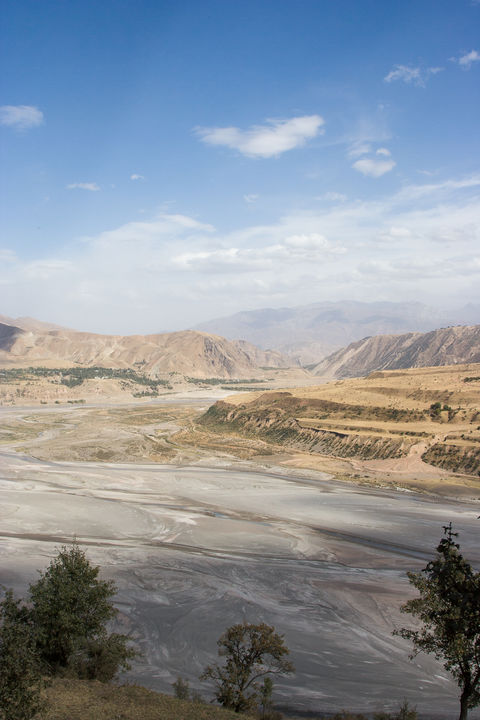Tavildara Road
Karategin, Tajikistan
A couple of hours out of Dushanbe, the good road runs out. From that point on, the road to Khorog alternates between broken asphalt and packed dirt. For most of its length, it's nominally a two-lane highway, although 'two lanes' sometimes translates to 'not quite enough space for two trucks to squeeze past each other'. The road is narrowest at the worst spots, where less than a metre of loose dirt separates the road from a precipice or a steep scree slope that drops hundreds of metres to the river below.
For most of the distance, the road hugs the mountainside, zig-zagging back and forth as it ascends. Looking out to the opposite side of the valley you get spectacular views of jutting peaks, cones of scree plunging down to the gray river below, sudden patches of green amid the gray-brown rubble where a stream spills out from the mountain wall. It's better to keep your eyes on the distance. Looking down calls for a strong stomach, as the wheels of your vehicle brush the fraying road edge and the turns offer you vertiginous glimpses of the valley floor far below.
Between the start of the dirt and Kalai Khumb, where the road descends into the valley of the river Panj and meets the alternate route via Kulyab, it crosses at least three mountain passes, each necessitating the same laborious climb and descent, the dusty road clinging to the contours of the steep slopes. Traffic is mixed: stocky little Kamaz trucks grinding their way up and downhill, olive-drab Soviet-era jeeps and combis, bouncing minivans, a smattering of the omnipresent Ladas and the occasional Chinese road train, feeling its way laboriously around the tight curves in bottom gear.
The road and its surroundings are surprisingly free of trash. The litter of plastic bags and bottles that disfigure roadsides in the rest of the developed and developing world are almost absent, perhaps a measure of the acute poverty of the Gorno-Badakshan region. What litter there is is larger: shattered pieces of earth-moving equipment strewn by the roadside and the chewed-over remains of Soviet armor. A handful of T-72 tanks, mostly stripped of everything except the turret and main gun, lie by the road's edge, reduced to near invisibility by a thick coating of white dust covering their pale-green paint, while bits and pieces of BMP personnel carriers can be seen in ditches and stream beds. These are apparently relics of the civil war and not, as I first thought, the product of a Tajik national holiday called Push a Tank in a Stream Day.
But the ruined machinery, like the poplar-fringed fields and the clusters of low white houses in the valleys, are mere accents in a landscape composed of dry rock. The mountains dominate here absolutely, towering massifs girdled with cone-shaped skirts of talus. Different rock types yield a continual succession of different views - here a peak painted with ice-cream-like swirls of red, white and brown, here sheer rock faces that appear almost quilted, here shallow cones of sand and friable rock, worn down by streams and punctuated here and there by beetling cliffs of harder stone that jut through from beneath.
On the valley floor, a broad gray river winds across a plain of silver-gray sand, and touches of occasional greenery reveal the presence of streams, but the dominant colors here are the colors of aridity — dark gray, sand and dirty brown.
